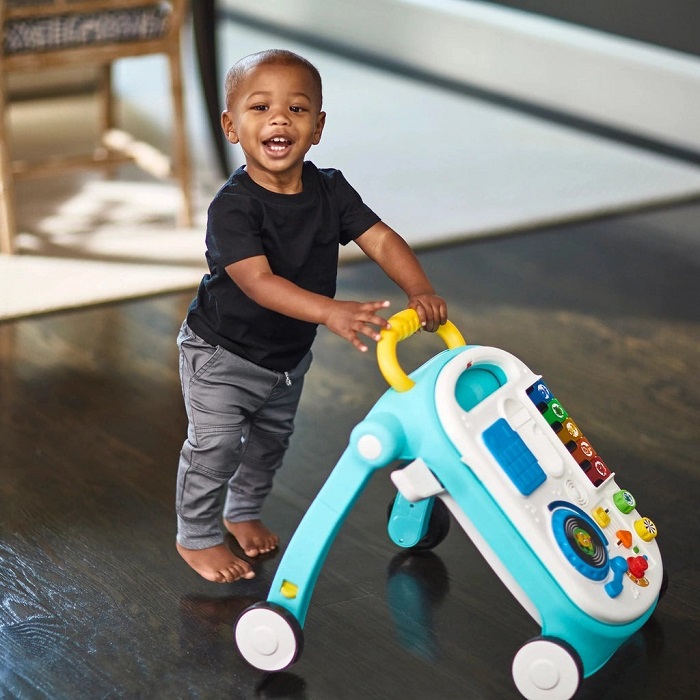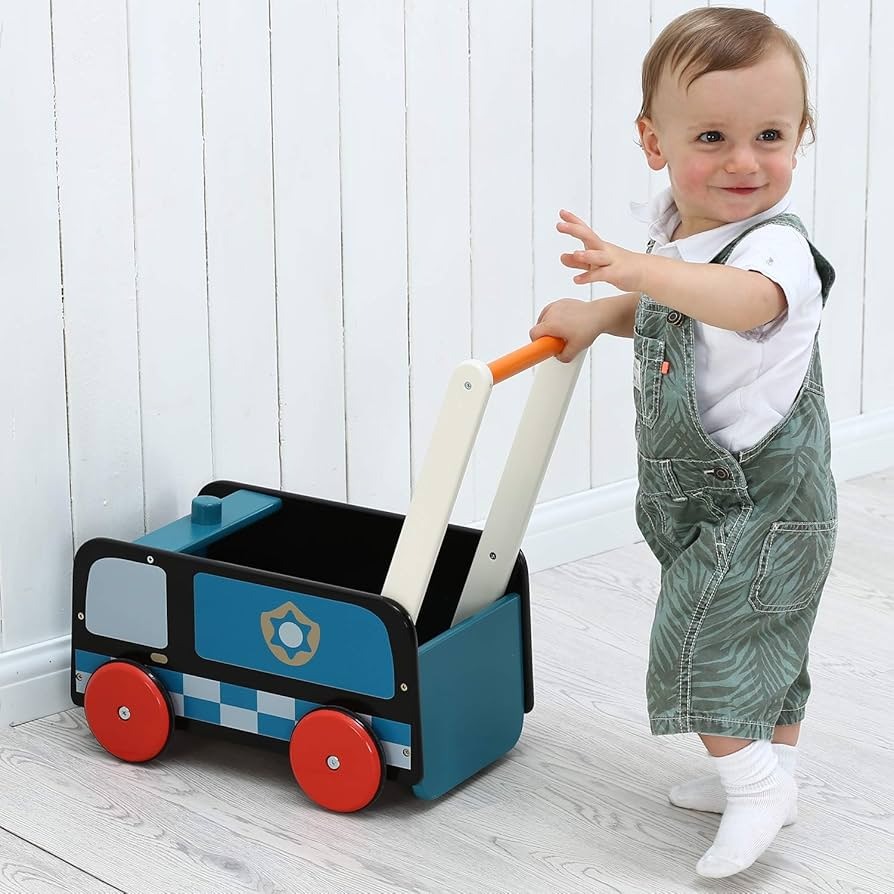Types of Push Walkers for Babies
When you’re in the market for the best push walker for baby, knowing the types available can help make your choice easier. Each type has unique features that cater to different stages of your baby’s development. Here are the common types of push walkers you’ll find:
Standard Push Walkers
These are the basic models that are lightweight and easy to handle. They often come with a simple handle and wheel base and may have some basic toys attached.
Activity Push Walkers
Activity push walkers offer more than just support for walking. They usually feature interactive panels with buttons, lights, and sound effects to engage your baby’s senses and encourage learning.
Sit-to-Stand Walkers
Designed to grow with your baby, these walkers start as an activity panel on the floor for babies who are sitting up. As your baby learns to stand and walk, the panel lifts to form a handle.
Musical Push Walkers
Music can be a powerful motivator for babies. Musical push walkers play tunes or make sounds when your baby pushes them, adding an auditory element to the walking experience.
Push Walkers with Adjustable Speed
For babies who are still getting the hang of walking, an adjustable speed push walker can prevent them from moving too quickly. These walkers allow you to control the pace, helping your baby build confidence and balance.
Choosing the best push walker for baby can be exciting. Look for a walker that aligns with your baby’s current abilities and also challenges them as they grow. Remember to consider space in your home, as some walkers may be bulkier than others. Safety, durability, and ease of cleaning are other critical factors to keep in mind. With these insights, finding the right push walker for your little one’s adventures can be both fun and rewarding.
Safety Features to Consider When Selecting a Push Walker

When shopping for the best push walker for baby, safety tops the list of priorities. Here are essential safety features to look for:
Sturdy Construction
Select a push walker with a solid build that can withstand your baby’s weight and movement. Ensure it does not tip over easily.
Wide Base
A wide base provides stability and reduces the risk of the walker tipping over when your baby leans into it.
Lockable Wheels
Wheels that lock are crucial. They prevent the walker from rolling away, especially on inclined surfaces.
Non-Slip Handles
Handles should have a non-slip grip. This makes it easier for your baby to hold onto the walker securely.
Speed Settings
Choose a push walker with adjustable speed settings. It allows you to slow down the walker to match your baby’s learning pace.
Brakes
A push walker with brakes gives an extra level of security. It stops the walker from moving when your baby doesn’t want it to.
Rounded Edges
Look for push walkers with rounded edges and corners to prevent injuries from sharp points.
By focusing on these safety features, you can rest assured that you’re choosing the best push walker for your baby’s needs and well-being.
The Benefits of Push Walkers for Baby Development
Push walkers offer important benefits for a baby’s growth and learning journey. They support babies as they develop motor skills and build strength in their legs. Here are key advantages:
Encourages Mobility and Independence
The best push walker for baby inspires little ones to move and explore. This boosts their confidence and fosters a sense of independence.
Enhances Motor Skills
Push walkers help babies coordinate their steps. This fine-tunes their motor skills, which are vital for future activities like running and jumping.
Promotes Balance and Stability
As babies learn to walk, balance is key. Push walkers offer support, teaching babies to find their footing and stay upright.
Stimulates Cognitive Development
Many push walkers come with interactive features. These engage babies’ minds and encourage cognitive growth through play.
Offers Safe Learning Environment
The best push walker for baby is designed with safety in mind. This allows babies to learn and play without undue risk of injury.
Grows with the Child
Many walkers adjust as your baby grows. This makes them a lasting tool for development through various growth stages.
Babies enjoy the freedom that comes with mobility. A push walker can be the perfect aid to encourage this important development phase. It helps build physical and mental skills in a fun, engaging way. The choice of a push walker should combine these benefits with safety and adaptability, to aid your baby through their developmental milestones.
Factors to Consider Before Purchasing a Push Walker

Before you decide on the best push walker for your baby, consider several important factors. Making the right choice depends on your baby’s unique needs, your living space, and the walker’s features. Here are crucial aspects to keep in mind:
Your Baby’s Age and Abilities
Select a walker that matches your baby’s current stage of development. Make sure it suits their age, and they are ready for it.
The Size of Your Living Space
Consider how much room you have at home. Ensure the walker fits well and can move around easily.
Walker Adjustability
Look for walkers that can grow with your child. Adjustable height and handles are key for long-term use.
Safety Certifications
Check for safety standards. Opt for a walker that meets current safety certifications to ensure it’s safe for use.
Comfort and Ergonomics
Choose a walker with a comfortable grip and ergonomic design. It should support your baby’s posture and movement.
Your Budget
Find a high-quality walker that also fits your budget. Quality matters, but there are great options in every price range.
Customer Reviews
Read reviews from other parents. Their experiences can provide insight into how the walker performs in real life.
By considering these factors carefully, you can find the best push walker for your baby. It will support their development, ensure their safety, and provide value for money.
Top Rated Push Walkers on the Market
Choosing the best push walker for baby requires research and understanding of what’s available on the market. Here, we will explore some top-rated options that have received positive feedback from parents and experts alike. These products stand out for their quality, safety features, and developmental benefits.
VTech Sit-to-Stand Learning Walker
This walker is a favorite among parents for its engaging activity panel that aids cognitive development. It’s versatile, serving as both an activity station and a walker.
Fisher-Price Learn with Me Zebra Walker
Noted for its stability and easy-to-use design, this walker encourages first steps and includes playful features that teach ABCs and 123s.
Melissa & Doug Deluxe Chomp and Clack Alligator Push Toy
Crafted with wooden materials, this walker offers a charming design and promotes coordination and motor skills through the amusing clacking of alligators.
Bright Starts Giggling Gourmet Shop ‘n Cook Walker
This innovative walker includes a removable cooktop for floor play and supports babies’ walking adventures with its sturdy design.
Little Tikes Light ‘n Go 3-in-1 Activity Walker
With a light-up activity panel and adjustable speed, this walker appeals to babies with its vibrant displays and customizable features for safe learning.
When looking for the best push walker for baby, consider these top contenders. They have shown to provide the safety, engagement, and development support that babies need during this critical stage. Always pair your choice with the considerations mentioned earlier, such as your baby’s stage of development, safety features, and the size of your living space. A well-rounded decision will provide your baby with an enjoyable and beneficial walking experience.
How to Ensure Your Baby Gets the Most Out of Their Push Walker
To make sure your baby benefits fully from the best push walker for baby, follow these tips:
Choose the Right Time
Start when your baby is ready. This is often when they can sit up or pull to stand on their own.
Create a Safe Area
Clear a space where your baby can move freely. Remove sharp objects and secure loose rugs.
Demonstrate How to Use It
Show your baby how to hold the handles and push the walker. Lead by example.
Supervise Playtime
Always watch your baby while they use the walker. Stay close to assist if needed.
Limit Time Spent in the Walker
Don’t rely on the walker all day. Allow time for other forms of play and movement.
Engage With Your Baby
Talk to your baby and encourage them as they move. Engagement boosts confidence.
Adjust the Walker as Needed
Change the height and speed settings as your baby grows and becomes more skilled.
Keep it Fun and Positive
Make sure the experience is enjoyable. Praise successes to encourage continued use.
By following these practical steps, you can maximize the developmental impact of the push walker on your baby’s growth. Make each walking session fun and safe, and your baby will look forward to using their walker as part of their learning adventure. Remember, the right approach, combined with the best push walker for baby, sets the foundation for a happy and active childhood.
Common Mistakes to Avoid When Using a Push Walker

As parents, ensuring the safety and development of your baby is paramount when using a best push walker for baby. However, it’s easy to make common errors that could hinder your baby’s experience. Here’s what you should avoid:
Choosing the Wrong Time to Start
Don’t rush your baby into using a push walker before they’re ready. Wait until they can sit up or pull to stand.
Not Checking for Safety Features
Always inspect the push walker for stability, non-slip grips, brakes, and a wide base before use. Missing these can risk your baby’s safety.
Overlooking the Importance of Supervision
Never leave your baby unattended with the walker. They need your close watch to stay safe.
Using a Push Walker as a Babysitter
The push walker is not a substitute for active playtime. It’s important to balance its use with a variety of activities.
Not Adjusting the Walker to Your Baby’s Needs
Adapt the height and speed settings as your baby grows and improves their walking skills. Using a poorly adjusted walker can impede progress.
Ignoring Your Baby’s Cues
Pay attention to signs of tiredness or frustration. Forcing use can make the experience negative for your baby.
By avoiding these mistakes, you can provide a positive and beneficial environment for your baby’s growth and enjoyment with the best push walker for baby.
When to Introduce Your Baby to a Push Walker
Knowing the right time to introduce a push walker can be critical for your baby’s safety and development. Here are a few signs that indicate your baby may be ready to start using a push walker:
- Ability to Sit Up Unassisted: If your baby can sit up without support, it may be time to introduce a walker.
- Interest in Standing or Cruising: Showing a desire to stand or walk by holding onto furniture is another good sign.
- Steady Upper Body Strength: Before using a walker, your baby should have enough strength to hold their upper body upright.
- Curiosity and Exploration: A baby who wants to explore their surroundings is likely ready for a push walker.
Remember, every child develops at their own pace. It’s important not to rush the process. You should consult with your pediatrician if you’re unsure about when to start. They can provide personalized guidance based on your baby’s milestones. Additionally, once you’ve introduced the walker, pay close attention to your baby’s response and comfort level. It’s okay to take a break and try again later if they don’t seem ready. When used at the right time, the best push walker for baby can be a wonderful tool to encourage walking and independence.